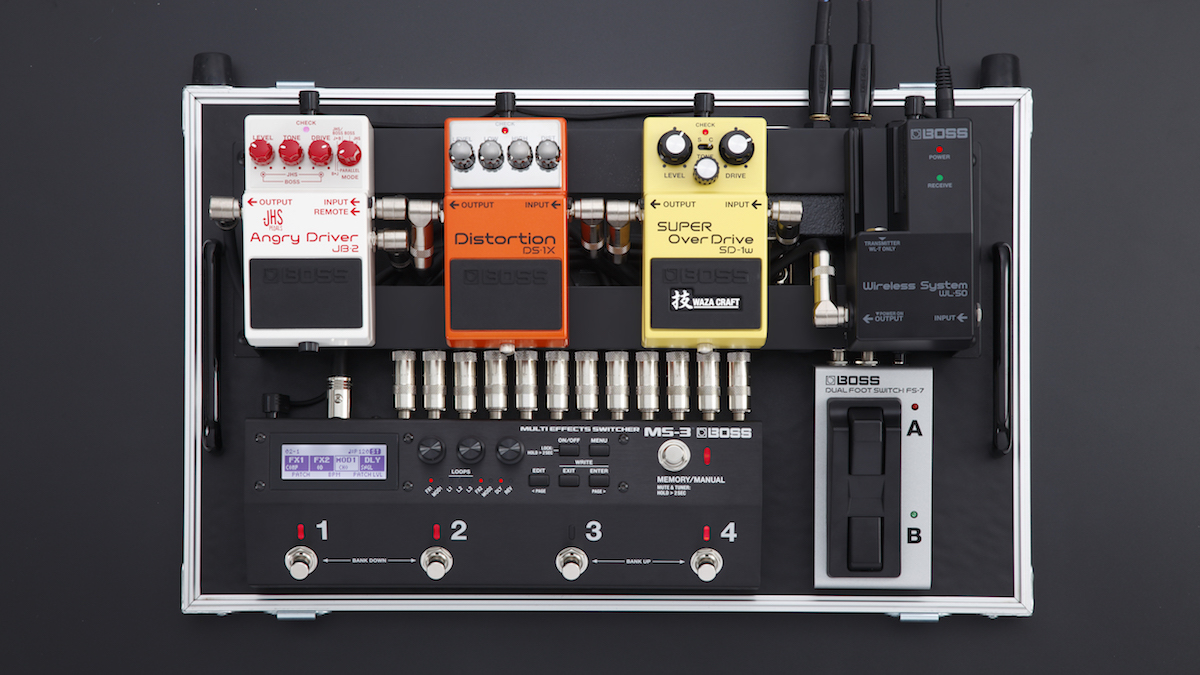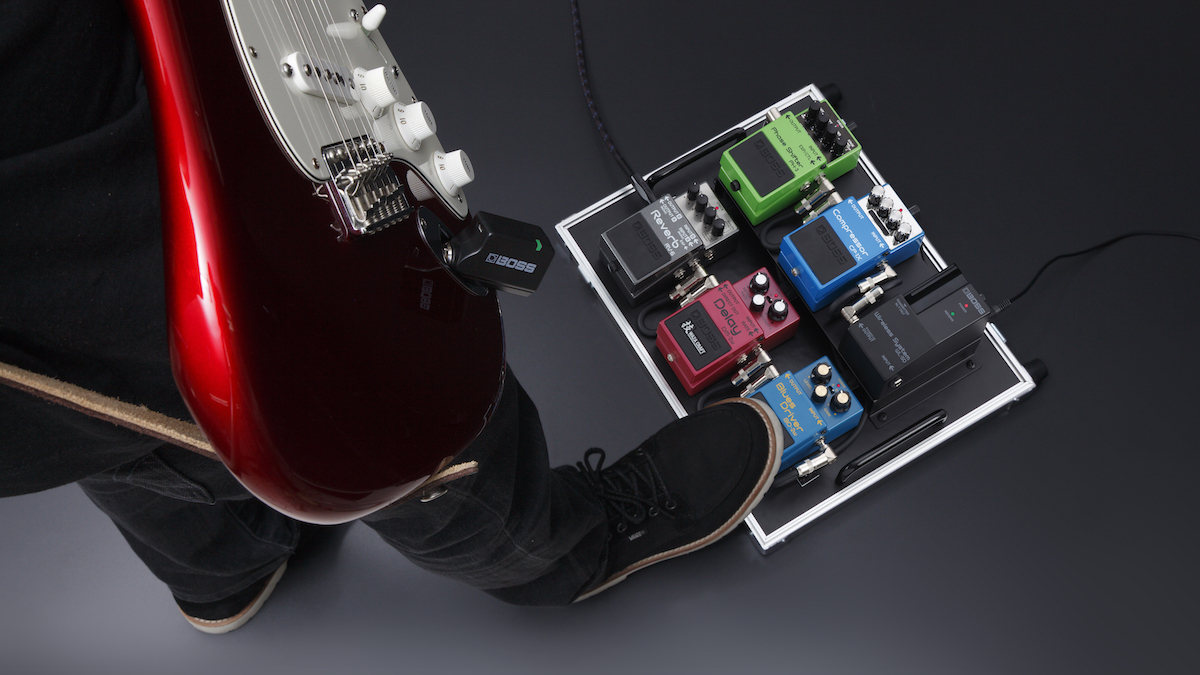6 reasons you should consider upgrading to a wireless guitar system
Let’s not tiptoe around anymore, when it comes to playing live it could be time to cut the cord

BACK TO LIVE: You’ve probably already noticed, but wireless technology has changed dramatically in the last ten years. From Bluetooth speakers and headphones, to mobile casting on smart TVs, and of course, the internet – wireless technology has been embraced en masse because it’s effective and much more convenient than running cables to connect devices. It's also become much cheaper, with a whole raft of cheap wireless guitar systems now available too.

A wireless system comes in two parts: the transmitter and the receiver. The transmitter - in the shape of either a dongle or a pack that attaches to your strap - connects to your guitar via its 1/4-inch output and sends your signal wirelessly to the receiver which plugs straight into your amp.
While the tech world has been more than happy to adopt wireless devices and appliances, the guitar-playing world has been a little suspicious of this type of sorcery. It’s not without good reason; early systems were prone to outside interference, weak signals and short battery life… plus that iconic Spinal Tap scene didn’t help the wider reputation of guitar wireless systems.
That is most certainly not the case now. The kinks have long been ironed out and modern wireless guitar systems can cover a huge range – usually around 100ft (30m) with a strong signal – have significantly improved battery life, and those interference issues are pretty unlikely these days thanks to much more advanced operating bands.
Wireless systems are not just at the point where they can hold their own against traditional guitar cables, they’ve surpassed them in pretty much every aspect. With the return to stages imminent, we’re going to go over some of the key advantages of setting up your rig with a wireless system.
1. No more tripping over cables
Let’s start with a biggie. Tripping over your cables has to be one of the most dangerous things about playing guitar. You (or a band member) can legitimately cause yourself an injury by getting tangled up in your cable and falling over – not to mention the risk of damaging your guitar or amp inputs in the process. Perhaps even worse, it’s also really embarrassing. It’s very hard to look cool falling over on stage – and that’s surely the most important thing at the end of the day, right?
In all seriousness though, having to tiptoe around your cables to avoid tripping over is a real issue. Not only can it be dangerous, having to mind your footwork and factoring potential hazards around the place can really take you out of your performance. By going wireless, you can take this out of the equation and just focus on your playing, and that really is the most important thing.

2. A life with less restrictions
This ties in with our first point to a great extent. Like most things in life, it’s just easier when you have less obstacles to contend with. We don’t want to sound like your life coach here, but many who have made the move to wireless have found it to be very freeing, and in more ways than one.
Get The Pick Newsletter
All the latest guitar news, interviews, lessons, reviews, deals and more, direct to your inbox!
Firstly, there are the physical restrictions you have with traditional cables. Even if you get super long cables, they just can’t compete with the range of a wireless system – many of which still offer a perfect signal at 15m (50ft) and some well-beyond that too, like the Sennheiser XSW-D which has an impressive range of 75m (250 feet).
Even if you have a cable of that length, you’re opening yourself up to all sorts of headaches with tangles and trip hazards, not to mention a reduced signal – it’s just far too impractical, especially given the other options out there. Once you’re wireless, you can pretty well go anywhere on or off the stage. Want to head out into the crowd, order a beer at the bar, nip off to the john, or simply just want a bit more freedom to move about in your performance? You can do it all when you’re wireless.
Secondly, taking away this physical restriction can actually improve your mentality as a performer. Knowing you aren’t tied to any point means you are totally free to play and move how you are feeling at the time, leading to more expression and in-the-moment magic. Surely that can only lead to positive things...
3. Make cable management history
You don’t have to be obsessive compulsive to get upset at the thought of a messy bunch of cables – it’s easily one of the most frustrating things about playing electric guitar. Not only are poorly managed cables unsightly, they are also not user-friendly and will require extra time getting them in order. Anyone who’s ever had to untangle a bunch of cables that have been tossed together in a bag from a previous gig or rehearsal will know just how time consuming and infuriating it can be.
Of course, you can limit this stress by implementing a proper cable management system; rolling up, clipping together, and securing your cables in their own designated area of your gig bag will ensure you don’t have to worry about this too much. On the other hand, it’s cumulatively a lot more work than just plugging in a wireless system that takes up a fraction of the space of even the shortest cables. If cable management gives you headaches, going wireless is kind of a no-brainer.
4. It's less likely to to be yanked out mid-solo
We’ve all been there before – the floor is yours, you’re just starting to feel it and then crack; you’ve stood on your cable, it’s unplugged and it’s all over. It’s frustrating enough at a rehearsal, let alone a gig in front of a proper audience. Of course there’s all the little tricks you can do, like pulling your cable through your strap or even duct taping it in place, but neither is a perfect solution – you can still step on the cable running to the amp, and tape adhesive can be a real pain to clean off your gear.
You just don’t have these dramas with a wireless system. There are far fewer instances where you might accidentally unplug one, so you don’t need to go overboard securing it in place. You almost have to be trying to dislodge them if anything. So if you live in fear of inadvertently ejecting your jack, just know it doesn’t have to be this way...

5. No random crackles from damaged leads
Even the best cables start to deteriorate eventually. No matter how good they are (or how much you paid), the nature of being thrown around, stood on, and rolled up is going to start causing damage over time. One of the key spots this happens is at either connector, but can really happen anywhere on the cable. It can sometimes be difficult even to pinpoint the exact spot – especially if there’s more than one.
Anything from crackles to completely dead signals are symptoms of a damaged lead, and this is the last thing you want to have to deal with on stage. Wireless systems, if properly looked after, won’t be manhandled as much and will simply serve you better. Sure, technical problems can still occur, but a wireless set up just isn’t going to be exposed to the same conditions that can cause cables to fail, making them more reliable in the long-term.
6. Save yourself money in the long run
On that note, think of all the cables you’ve owned. If it’s more than five, then you have already splashed out the cost of a fairly decent wireless system in cables alone. Technology in this field has improved so much in the last ten years that not only is this equipment better and more reliable, it’s also far more affordable than you might think. You can actually get pretty decent and reliable systems for well under $100, like the Ammoon 5.8 Ghz Wireless Guitar System; a fairly formidable offering you can find going for just $65. While this is obviously a bigger financial outlay than just buying a new cable, you have to remember your wireless system is going to outlast a standard lead, especially if you’re a gigging musician who likes to throw their cables around a lot.
A wireless system is just not subject to the same conditions and is easier to take care of. Providing you exercise some care and a little common sense, you should expect a wireless device to serve you well for many years.
Chris is a contributor to Guitar World and MusicRadar with around 20 years of guitar playing experience – including writing for and recording various projects for around 15 of those. Outside of practical experience, he’s studied music throughout his life, with a particular focus on composition at university. He’s something of a 90s tragic and a sucker for anything with a groovy, metallic edge or psych and stoner vibes. Outside of music, he’s an avid cook, gardener, and rugby league lover.
“Jimi was staying at a hotel in Times Square. He had his hair set in pink curlers and we would just talk band drama”: Electro-Harmonix founder Mike Matthews on befriending Hendrix, booking Chuck Berry and the birth of pedal culture
“An affordable and extremely useful creative tool for podcasting, streaming and studio or location recording”: Shure MV7i Smart Microphone and Interface review





![[from left] George Harrison with his Gretsch Country Gentleman, Norman Harris of Norman's Rare Guitars holds a gold-top Les Paul, John Fogerty with his legendary 1969 Rickenbacker](https://cdn.mos.cms.futurecdn.net/TuH3nuhn9etqjdn5sy4ntW.jpg)





